How to Use Single Keyword Ad Groups (SKAGs) to Drive Highly Relevant, Highly Targeted PPC Traffic

Whether single keyword ad groups (SKAGs) are old news or a new find to you, they’re quickly becoming a well-known best practice for PPC account setup.
First, what are the main benefits for ecommerce managers and brands?
Why SKAGs Are Important for Ecommerce Brands
Get a granular overview of your campaigns. Make AdWords campaign optimization more effective with better tracking.
Relevance, Quality Score, & Expected CTR. Create highly specific ads to improve your Quality Score and click-through rate to drive more traffic and sales.
Optimizing & Expanding Single Keyword Ad Groups. Easily identify your top performing products/services to adjust your campaigns appropriately.
There are quite a few different ways to organize your campaigns when it comes to AdWords, so you’ll want to make sure you’re using what’s been proven to work.
Certain types of campaigns call for certain types of audiences and ad groups.
But in the world of PPC, where bids and clicks slowly chip away at your ad budget with every drop of traffic, it’s important you keep campaigns focused.
Focused on what?
Focused on generating traffic that’s going to generate the highest ROI.
You can’t afford to be wasting ad spend on keyword bids that are generating low intent traffic by targeting too large an audience.
The “larger audiences” I’m referring to here are the ones brought in by the many search queries tied to broader keyword match types that are plaguing your ad groups — or what we at KlientBoost call the “Iceberg Effect.”
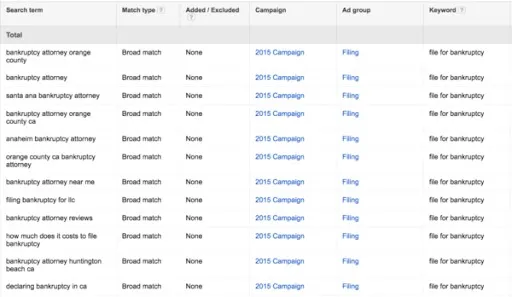
An example of the Iceberg Effect — look at how some of the queries really differ from the keyword. – image source
The image above shows how most of the search terms that are triggering the ad are completely irrelevant to what the ad is offering. Broad match keywords are typically part of the problem.
The ad is specific to the keyword “file for bankruptcy” but not all these queries come from people with the same intent or interest level.
This isn’t going to do anything good for your click-through-rates (CTR), which – in turn – will hurt your Quality Score as well.
These wasteful campaigns drain your ad spend without generating actual conversions and revenue.
Basically, they’re just throwing your ad budget on the pyre and hoping for solid traffic.
But don’t worry…
There’s a better way. And the way is: Single Keyword Ad Groups (SKAGs).
SKAGs organize your campaigns into highly targeted and highly relevant ad groups to boost ad relevance, Quality Score, and CTR.
So, from the original masterminds behind SKAGs, here’s why you need to start using them in your own AdWords campaigns (and how to set them up).
What Are Single Keyword Ad Groups?
As I previously mentioned, SKAGs are a way of segmenting your ad groups by keywords to maximize their relevance.
This in turn improves other metrics that help lower your cost-per-click (CPC) and improve your CTR.
Let’s take a look at an average ad group first, so we have a baseline for comparison:
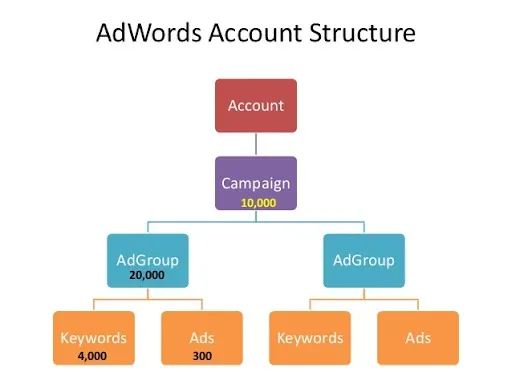
Here’s a basic ad group setup, using multiple keywords, – image source
You can see in the previous report about filing for bankruptcy the search terms and keywords don’t ever match up, which is a big no-no.
If you don’t know the difference:
A keyword is how AdWords manages what you bid on and what keywords trigger your ads.
A search term is what the user actually types into the search bar (after all, you’re advertising to humans here, not Google).
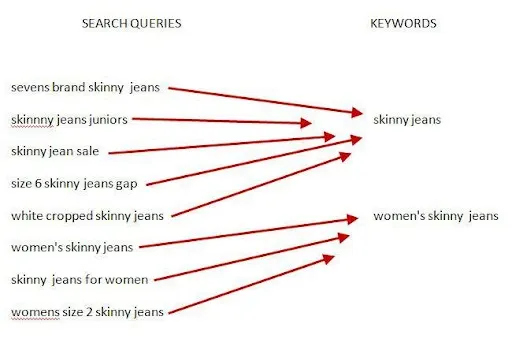
Search term versus keywords – image source
If you have too many keywords within an ad group, not all of them are going to be a perfect match for the search term or ad you’re serving.
You want to cut down your keyword:search term ratio to be as low as possible. Ideally, a 1:1 ratio.
Building your ad groups around keywords that match search terms rather than several keywords you’re taking a guess at via SKAGs will help improve the relevance of your ads by minimizing the keywords that trigger your ads.
Your ads may show to a smaller audience, but it will be isolated to users entering only search terms that are relevant to your ads.
Which is exactly what we’re looking for: highly relevant traffic with the highest likelihood of converting.
That’s how you maximize the ROI of your PPC campaigns.
How To Set Up Single Keyword Ad Groups
Now that we’ve addressed what SKAGs are in an abstract sense, let’s take a tangible look at how to set them up.
For continuity’s sake, let’s use the same example as the ordinary ad group that I referenced earlier.
The original ad group included the following keywords:
Skinny Jeans
Women’s Skinny Jeans
The screenshot above shows these keywords were triggered by a myriad of different search terms — some relevant, some not.
The search terms triggered:
Seven brand skinny jeans
Skinny jeans juniors
Skinny jeans sale
Size 6 skinny jeans gap
White cropped skinny jeans
Women’s skinny jeans
Skinny jeans for women
Women’s size 2 skinny jeans
If we have one keyword and one match type, that’s extremely limiting.
By using different match types, you can still have a 1:1 ratio without limiting relevant traffic too much.
We use three for every keyword in every ad group that I will note below.
Keyword Match Types
For starters, each SKAG is built around a root keyword. This is the primary keyword that you’re trying to target.
So, for the example we’ve been using, the root keyword would be “Skinny Jeans.”
However, if you only build an ad group around this keyword and rely on the default Broad Match, you’ll notice quite a large keyword:search term ratio (or Iceberg Effect).
That’s because, of all the keyword match types, broad match has the largest Iceberg Effect.

The Iceberg Effect in an abstract sense (don’t be the Titanic). – image source
Which means that your ads will be triggered for the largest audience, but not necessarily the most relevant.

The hierarchy of Match Types by Iceberg Effect – image source
To build an effective SKAG, you need to use all the different match types (except broad match) to mitigate the Iceberg Effect as much as possible.
Therefore, a SKAG targeting the same keyword as the original ad group would look something like this:
+keyword+1 (broad match modifier)
“keyword 1” (phrase match)
[keyword 1] (exact match)
Using these keyword match types will help adjust your ad group to monopolize a singular search term (your root keyword).
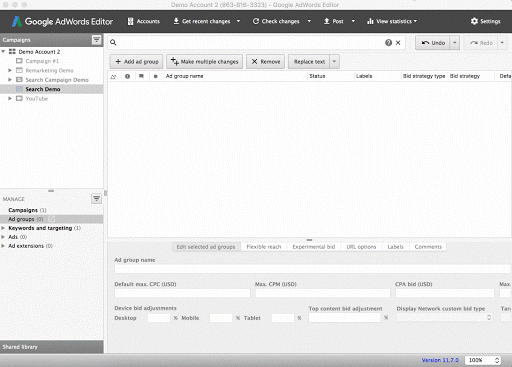
Entering a SKAG into AdWords – GIF source
How Match Types Work
Your broad match modifier will trigger your ads for any relevant long tail versions of your keyword, no matter the order.
On the other hand, your phrase match has to include the keyword(s) in the order you’ve put them in, but can include additional keywords (as long as they don’t impact order of main keyword).
And exact match keywords are just as it sounds, no additional keywords can be added — it is what it is.
We keep our single keyword ad group flexible by having various match types for that one keyword.
NEED TO KNOW
Considering that the basic logic behind SKAGs is that granular segmentation improves performance, you might find yourself thinking about segmenting your ad groups even further.
The drawback here is that SKAGs already dilute your audience quite a bit, which makes testing difficult.
Further diluting your audience by splitting your SKAG into three distinct ad groups based on match type will making testing nearly impossible.
Segmenting by just one keyword is enough on its own.
The Benefits Of Single Keyword Ad Groups
We’ve addressed the value of SKAGs – what they are and how to set them up – but what are the real benefits of this AdWords strategy?
Granular Campaign View
Well, for starters, it gives you a clean, granular overview of your campaigns that makes further adjustments and optimization easy.
You may have to deal with a large number of ad groups in any given campaign, but it’s easier to see each ad group’s performance — because you’re not having to figure out which keywords are performing the best within that ad group (just what match types).
The easier your tracking is, the easier optimization is.
But a clearer picture of your campaigns isn’t the only benefit of slicing up your accounts into SKAGs.
The real benefits come from SKAGs’ ability to improve your ads actual performance.
And that comes from the improved relevance of your ads.
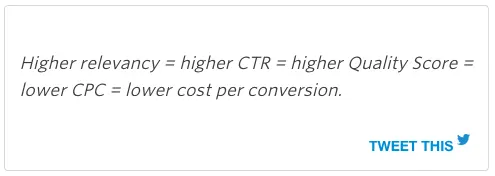
Our favorite quote from our original SKAGs article via Unbounce – image source
Relevance, Quality Score, & Expected CTR
The leading benefit of SKAGs is that, once you have tapered down your keyword:search term ratio, you’re able to create ridiculously specific ads for your target audience.
When you start matching a keyword to search terms in a more 1:1 way with highly specific ad text, your CTR can skyrocket.
This is because you don’t have multiple keywords all battling one another to be relevant to a single ad you’ve created.
Effectively, SKAGs cut down the ratio between search term to keyword, and from keyword to ad.
And the more specific you get in both areas, the mores success you’re going to see.

Hyper relevant ad example from the original SKAG post – image source
Creating hyper-relevant ads like the one above will in turn increase the Quality Score of your ads.
Quality Score is somewhat of a Google black box, but you can rest assured that relevance has something to do with it.
The increased relevance of your ads will actually have a two-fold effect:
Increased Quality Score
Higher Expected CTR
Now, because Google gets paid each time your ads are clicked, the higher your expected CTR, the more Google will like your ads.
And what’s your reward? A lower CPC for your campaigns.
This is great news — it literally means you are paying less for more traffic which also has a higher conversion intent.
That’s what we call a win-win-win.
Optimizing & Expanding Single Keyword Ad Groups
The last – and one of the best – benefits of single keyword ad groups is that optimization is so easy, and helps merchants identify what products or services are doing well.
SKAGs are essentially built self-optimized because of their use of the three different keyword match types.
Instead of continually updating your ad groups with new long-tail variations, you can rely on your broad match modifier to trigger your ads when you want.
All you need to do to optimize your SKAGs is to check-in to your Search Term Report to eliminate any irrelevant search terms and/or identify potential new SKAGs.
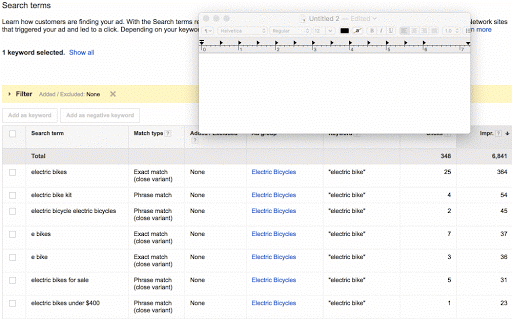
Here’s a GIF of what it looks like. – GIF source
For example, if you’re checking your SKAGs Search Term Report weekly, you may find new search terms that are related to your root keyword, but carry a different level of intent.
For these, you can add them to an ad group to create a new SKAG that monopolizes that search term.
The Importance of a Negative Keyword List
However, first, you must add them to your original SKAG’s negative keyword list. This way, your original SKAG’s audience will grow even smaller and thus even more relevant.
You don’t want to compete against your own ads.
Remember, while you may have an urge to maximize the reach of your ads to engage with the largest audience possible, the golden rule of effective PPC is that a smaller audience is actually better.
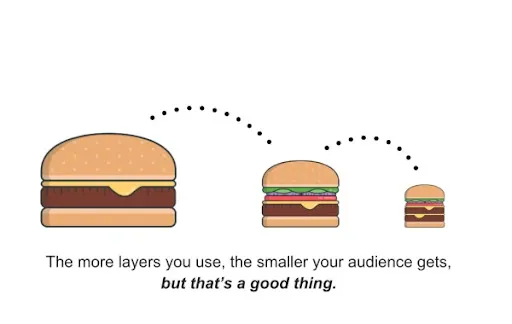
More targeting layers make a smaller audience, which is a good thing. – image source
Merchants can use this technique to see which of their products or services are doing well in their AdWords account.
Ad groups that outperform their counterparts in the campaign can be broken out into their own campaigns with a dedicated budget, and the previous campaign’s budget can also be adjusted accordingly.
SKAGs allows you to better track your products’ or services’ ROI and improve your AdWords strategy around your various products and services.
Executive Summary: More Granularity is a Good Thing
So what’s the magic behind single keyword ad groups?
What makes them so vital to your AdWords campaigns?
The answer is simple: If you pay for every click of traffic you generate, you only want to generate clicks for highly relevant, high intent traffic.
And that’s exactly what SKAGs segmentation achieves.
The smaller your audience, the more you’re able to create highly relevant ad content/copy that yields more clicks at lower costs.
Those are some figures that I think any ppc marketer can get behind when building successful adwords campaign.
Article edited with the online wysiwyg HTML editor. Subscribe for a HTMLG membership to stop adding promotional messages to your documents.

Johnathan Dane is the founder of KlientBoost and Kite, a PPC and CRO agency with a software advantage that hustles for results and ROI.


